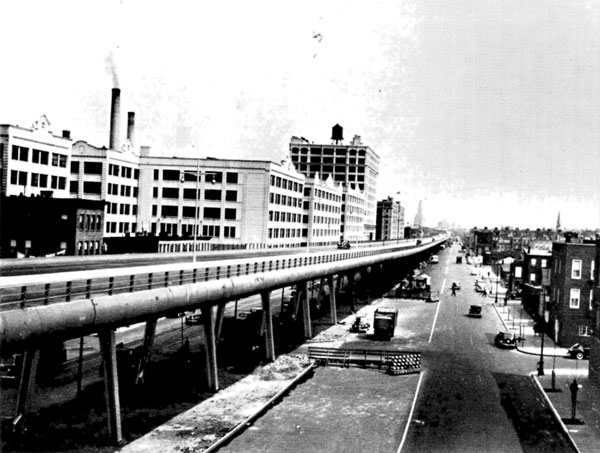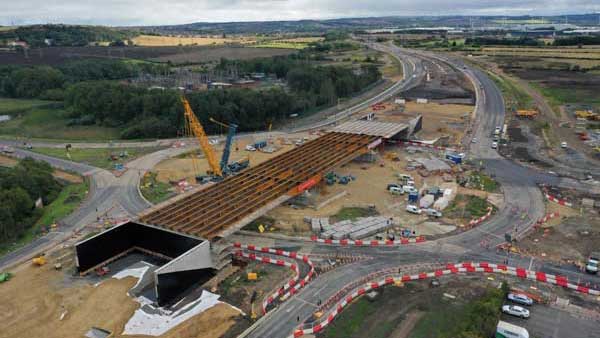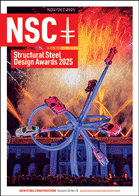50 & 20 Years Ago
Highway problems – the American solution
FROM
Building with Steel
AUGUST 1960
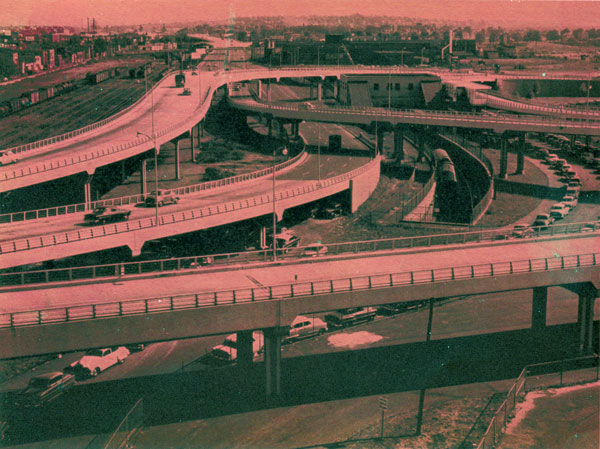
By common consent one of the most urgent problems that confronts this country at the present time is the organizing and laying out of suitable motor-roads, to accommodate the ever-increasing number of vehicles crowding on to roads which were, in the main, built for the transportation of coaches.
While everybody appreciates that we live on a comparatively small island, yet it has to be admitted that progress designed to combat this important problem has been, to say the least, halting in every direction. For years the country has been promised a solution but a continuing paralysis has prevailed; today the authorities find themselves in a very awkward position of nothing done and a spate of new vehicles overwhelming them and the roads. The new Minister of Transport is trying many ingenious methods to bring order into chaos; most of these methods are up to now however, palliatives and not cures.
Some progress is being made on main arterial roads; but new main arteries very often serve only to speed up the flow of traffic between one city and another, and in the process aggravate already existing problems by increasing city ‘bottle necks’ of traffic. In the final result little or no improvement is effected in the general movement of traffic.
Every country has this traffic problem and some, particularly the United States, have set about it in a workman-like way and have at least achieved something. It was, therefore, of interest when we came across a brochure published in Germany – by Beratungsstelle für Stahlverwendung, Düsseldorf to whom we are very grateful – but descriptive of American Elevated Highways built in their towns and cities. The illustrations speak for themselves and the following description has been translated from the German in order to give readers of Building with Steel an opportunity of seeing something of the methods adopted by others in their efforts to move vehicles at a reasonable pace from one end of a town to the other. It will be seen that the methods have to be very drastic indeed and structural steel has played a very important part in helping to solve the problem. All the illustrations in this article are steel structures and we do recommend engineers to study the methods which are described and illustrated in this feature.
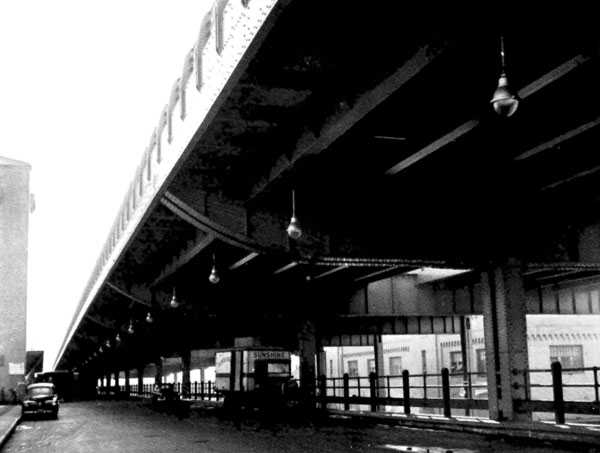
CITY TRAFFIC PROBLEMS – NEED FOR A SECOND LEVEL
The practice of building new roads and widening existing ones outside the towns· cannot generally be followed in the towns themselves. In most cases an effective solution for town traffic is to be found solely in the construction of overhead roads of dual-carriage type, free of crossings and other obstacles, with at least four and preferably six traffic lanes, leading from the existing streets at ground level, and linking the town centre to the trunk routes with tangential or ring roads. American experience has shown that the alternative solution of constructing underground expressways must be excluded for economic reasons. The cost of underground systems becomes even more inadmissible when the question of junctions is considered. Underground construction is, however, used in certain cases where the path for an overhead road is blocked by a concentration of buildings, or when a steep hill intervenes. Finally, such methods are favoured where protection from aerial attack is desired.
ADVANTAGES OF STEEL-FRAMED OVERHEAD ROADS
Steel construction is particularly suitable for overhead urban highways. It has the advantage of lending itself to extensive workshop prefabrication: erection is rapid and requires little space, and wide spans are possible. In addition, steel structures can be rapidly altered or enlarged and this is important in view of rapid urban growth. Another useful property of steel construction is ease of adjustment in case of subsidence or landslide damage. Finally, steel construction allows the use of slender columns with minimum obstruction to the lower network of streets.
OVERALL TRAFFIC PLANNING VITAL
Overhead urban highways can only solve present and future traffic problems if they are an integral part of an overall plan for traffic. They must form arteries which connect the ground-level streets of towns organically with the trunk roads outside the town. The overhead roads must also connect with the roads used by short distance local traffic. This implies that the overhead roads must be fully integrated with existing and planned road systems, town centres and sub-districts, as well as parking places, garages and filling stations. The planned inclusion of urban overhead roads in the network of public bus-service routes is vital, as is also the provision of proper communications between the overhead roads and railway stations. In all town centres therefore there must be planned integration of one or more transport depots with the overhead road system.
An essential prerequisite for the correct planning of an overhead highway and its incorporation into the overall traffic scheme, is a careful analysis of traffic with an eye to future trends. Finally, attention must be paid to ensuring that the appearance and architecture of the overhead ways are beyond aesthetic criticism and blend effectively with the town as a whole. All this is a worthwhile challenge which calls for real teamwork between top-class experts, architects, constructional engineers, and especially town planning officials. It can also be an advantage to appoint a co-ordinator acceptable to all parties.
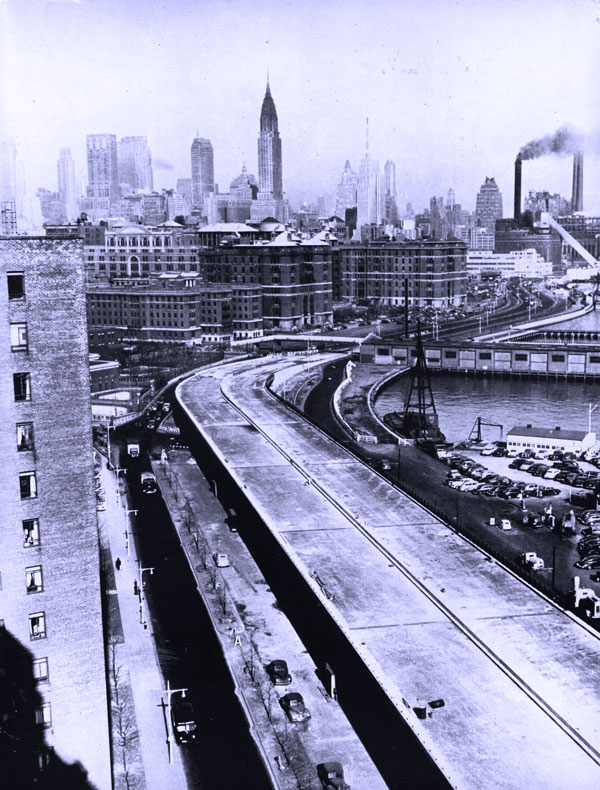
THE AMERICAN OVERHEAD HIGHWAYS
Difficulties resulting from growing motor traffic manifested themselves rather earlier in America than elsewhere. The consequence in such giant cities as New York and Chicago were particularly unpleasant. The Americans did not shrink from radical measures to solve their traffic problems and accordingly they built their Expressways or Freeways predominantly as elevated highways. This happened for the first time on any scale in the nineteen-thirties and today in many large American towns this system is the only one applied. This type of overhead road displays the following characteristics:
- dual-carriage type with at least four lanes;
- absence of cross traffic at most if not all junctions; no building obstructions;
- adaptable for speeds in excess of 60 m.p.h.;
- gradient of main highway 1 : 30
- gradient of entry roads 1 : 20
- gradient of exit roads 1: 15
- continuous verge for broken-down or stopping vehicles; acceleration and deceleration lanes connecting entry and exit roads;
- lighting in built-up areas;
- open only to power-driven traffic;
- free from tolls.
A number of American elevated Highways are illustrated in this article.

FLYOVERS AT TRAFFIC JUNCTIONS
Crossings and side turnings off busy streets are frequently trouble spots in urban centres. They are a danger as well as a hindrance to traffic. At such points, flyovers taking the main flow of traffic over the junction, can greatly relieve the situation.
INDUSTRIAL OVERHEAD WAYS AS MODELS FOR ELEVATED ROADS IN TOWNS
In industrial installations carrying heavy traffic similar problems to those existing in town centres can arise. In these cases, of course, goods traffic is involved but irrespective of the composition of the traffic, the elevated way offers an equally valid solution. In the German steel industry for example, overhead ways have been erected in steel works, providing a second level for lorry traffic. As a result, demolition of existing buildings could often be avoided, thus saving valuable space for devotion to production purposes. Safety benefits also frequently accrued.
Acknowledgment is made to the following, for photographs included in this article:
John Hotchkiss.
D. B. Steinmann.
American Institute of Steel Construction, Inc. All of New York.
Bethlehem Steel Co., Bethlehem, Pa.
Department of Public Works, Division of Highways, Sacramento, Calif.

